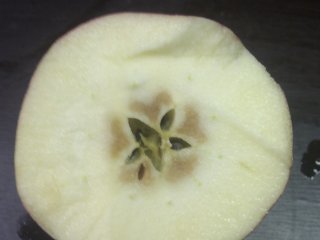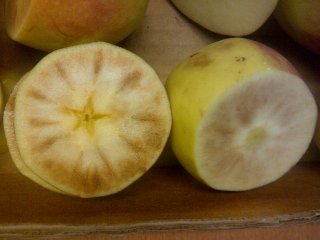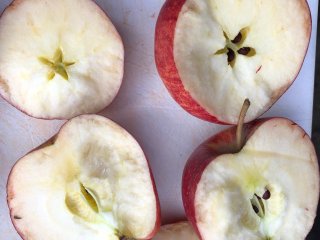
Internal apple disorders that develop after harvest
Several internal disorders of apples develop during storage or shortly after storage. Most of these disorders are only visible when cutting the apple into pieces. Here an overview is provided of the main internal disorders that occur after harvest.
Overview of internal disorders that may develop after harvest
-

Core browning
Core browning or also called 'core flush'. The flesh close to the core cavity is discoloured. The tanning can vary from diffuse light brown to dark clearly bounded areas. This disorder is associated with senescence (overripe apples) or with storage conditions (higher CO2). -
Freezing injury
Freezing injury is serious. Apples may be able to withstand several days or even weeks at -2 °C (28 °F), but are irreversibly damaged when the frost is more severe. The apples can still look healthy in freezing temperatures and in the first 24 hours after thawing. But the flesh soon becomes watery, soft and with a brownish colour. -
Internal CO2 damage
Internal carbon dioxide (CO2) damage can appear as internal browning in the fruit flesh, sometimes also with cavities. This affected area is usually located around the core or middle part of the fruit flesh with a healthy zone of about 1 cm directly under the skin. A preventive measure for storage facilities is to start Controlled Atmosphere conditions only after the fruit has cooled down. -

Low oxygen injury
Low oxygen (O2) injury can become visible as browning on the apple's skin and expanding under the skin into the fruit tissue. The skin and tissue under the affected skin is soft. The symptoms of low oxygen injury then have similarities with soft scald. Low O2 damage be recognized at an early stage by an off-taste. A preventive measure is to start Controlled Atmosphere conditions only after fruit has cooled down. -

Low temperature breakdown
Low temperature breakdown (LTB) leads to fruit flesh that turns greyish and later browns. Typical for low temperature breakdown is a few millimeters of healthy tissue just under the skin. Apples that are harvested late (riper) are more susceptible. A low moisture loss in storage can increase symptoms. -

Mealiness
Mealiness (or mealy breakdown) is a sign of an overripe apple. The apple may look good on the outside, but the flesh is too soft. The apple tastes dry with poor aroma. It is a form of 'senescence breakdown'. In very severe cases, the skin can even burst. -

Off-taste due to alcohol formation
Off-taste due to alcohol formation can occur if the fruit was stored in too low oxygen levels. In an early stage the symptoms may disappear again if the oxygen level is increased. After prolonged exposure to too low oxygen, the affected flesh has an odour of fermentation and an off-taste. The alcohol formation can lead to 'low oxygen (O2) injury'. -
Senescence breakdown
Senescence breakdown (browning) is associated with soft tissue. The tissue throughout the apple (also just below the skin) first becomes soft and mealy and eventually leads to senescence browning. In very severe cases, the skin can even crack. The apples with senescence breakdown have been stored under suboptimal conditions such as too high temperature or are simply stored for too long.